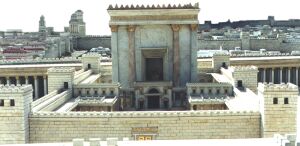Parashat Tazria – Metzora 
The (usually) double portion of Tazria and Metzora deals for the most part with the sickness of “tzora’at,” which is usually translated as leprosy. However, it stands to reason that tzora’at was a different ailment than that which goes by the name of leprosy in these days. Also, it seems that tzora’at did not entail great suffering and pain on the part of the sick person. It was some sort of rash broken out on the body’s skin, but instead of going to a doctor, the sick person went to the cohen (priest).
How many types of tzoraas can afflict the human body? It can take the form of an affliction of the skin, an affliction on a wound, or an affliction of the beard or scalp. However, Ramban explained that tzoraas was not a natural ailment at all. Because Israel has a unique relationship with G-d, the spirit of G-d rests upon them. Consequently, the bodies, clothing and houses of Israel have a pleasant visage. However, if one of them sins, then an ugly blemish appears on his body, or his clothing or in his house, because the spirit of G-d is then removed from him. What type of clothes were susceptible to receiving tzoraas? Woollen or linen garments owned by Jews which had not been dyed. Finished threads of wool and linen can also accept tzoraas. Leather and a hide designated for some practical use or fashioned into a garment or utensil can also accept tzoraas.
The Kuzari writes that tzora’at was found only when Klal Yisroel was on a high level, and the Divine Presence dwelt among them, in their bodies, clothes, and houses, like the soul in a body. In the same way that when the soul leaves the body, the body’s form changes. So too, when the Divine Presence leaves because of his sins, there is a change in the body, clothing, or houses.
The Alshich points out that the parsha of tzora’at is introduced with the word “Adam” (a person). The word “Adam” always denotes a person of stature and importance; not a regular person. Tzora’at does not affect just anyone, but only people on the correct level. He writes that Chazal tell us that the primary cause of tzora’at is the sin of slander. If a person sullied himself with the sin of slander, the person’s inherent holiness would push the impurity gained through this sin out of his body, and it would manifest itself as tzora’at. In our days, people are not on this level, and therefore, we are not afflicted by tzora’at.
One who is stricken with tzoraas is called a “metzora.” He acts and dresses like a mourner. His clothes are torn. The hair of his head shall be shaved, he pulls his collar or scarf over his lips, and pulls his cloak over his head. He must also warn people to stay away from him, in order not to contaminate them. The word metzora hints at the phrase “motzi shem ra,” which includes the two sins of speaking lies or lashon hara about someone else. Thus, we are taught what the cause of the sickness was: speaking things that are prohibited.
The Chofetz Chaim writes that we find 3 types of impurities. One is caused by a dead person. Another, by certain excretions from the body (Zava). The third is tzora’at. The Metzorah is the only one that is sent out of all three camps of Bnei Yisroel and must sit in complete isolation. This shows the severity of gossiping. The truth is that we may not appreciate the severity of this prohibition, and think of it as a mere “good thing,” but, in the eyes of our Sages, it is counted among the worst of sins. We are quick to justify our speech against others with uneducated excuses, while, in truth, we may transgress many real prohibitions by opening our mouths. The prohibitions against speaking Loshon Hora are not any less than the other prohibitions in the Torah which we all keep dearly-who would ever eat chazir (pig)? Yet, our unguarded words may even be more severe than chazir.
Speech is the foremost medium by which people connect with each other. Although each person is an individual and unique creation, a world unto himself, with his own special purpose, nevertheless, it was the Will of the Creatorthat the world should be built upon social relationships. Every person needs them, relies upon them and depends upon them. Indeed, the network of human inter-relationships is one of the meanings of the verse, “The world is built upon loving kindness (chesed)…” (Psalms 89:3), where the quality of loving kindness indicates the bond between people. On the other hand, social interactions can also be a great danger to the individual if he falls into bad company. They can drag him, without him realising it, into losing his uniqueness and forgoing the special purpose for which he was created.
The Talmud (Sotah 32b) tells us that the metzora shouted out ‘tamei, tamei!’ (Unclean! Unclean!) to publicise his predicament so that people should pray for his recovery. The Zohar states that the prayers of a person who speaks lashon hara is not accepted. Since the metzora has spoken lashon hara, his own prayers will not help. Therefore he needs others to pray on his behalf. The Talmud adds that the same applies to anyone who is suffering. He should speak to people, and they will pray to G-d for him. In fact, we should pray for him even if we are not explicitly asked to do so.
The Dubno Maggid writes that the reason people make light of the laws of gossip is because they are not aware of the power of the mouth. The leper, who was afflicted because of his misuse of speech, was brought in front of the Kohen. His being considered pure or impure was now dependent on the proclamation of the Kohen. The words “pure” or “impure” would determine his future. This would be his lesson in the power of speech.
Thus, it may well be that a person will use his power of speech for evil. When he sins in this way he turns the instrument which was created to connect people to each other in order to assist each other into an instrument of destruction which damages and hurts. In other words, that which was created to connect people becomes an instrument to alienate people from each other.
Therefore, the rectification for this sin, visiting the Kohen as it is described in the Torah, is understandable. After that, the leper must reside for a period of time outside the camp, outside the settlement, divorced from the company of others. He caused alienation, and now he is forcefully separated from others.
In the Aramaic translation of the Torah, the Targum Onkelos, tzora’at is called “segiruta,” which literally means isolation. In other words, the person who has sinned by speaking badly must be isolated from human company. One of the purposes of isolation is to force the sinner into a state where he will consider his actions and speech. Forced to be alone, he will contemplate how he fell into his unfortunate situation. Cut off from conversing with anyone else because of his own bad speech, he will have the chance to rectify his ways. Once he has repented, then the sign of his cure will appear on his body as well. Then he goes to the priest who can declare him fit to re-enter the society of men.
Seen in this way, we are forced to realise that the sickness of tzora’at was a sort of Divine gift to assure that we do not stray too far from the way of G-d into the realm of evil. Therefore, this “barometer” of our spiritual state is among those gifts and virtues whose recovery we await when the Divine Presence returns to Zion. Soon may it come!
SHABBAT SHALOM





